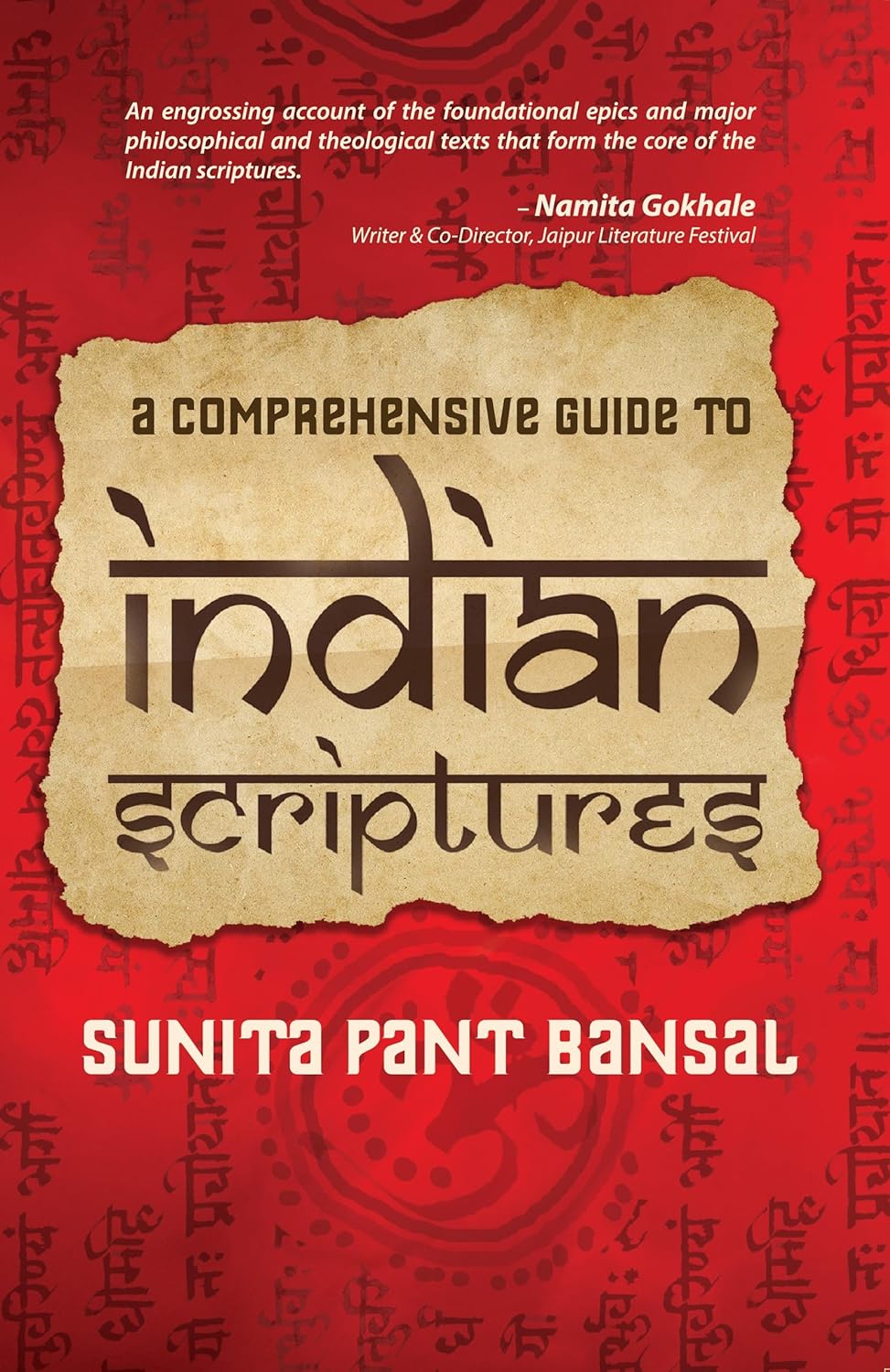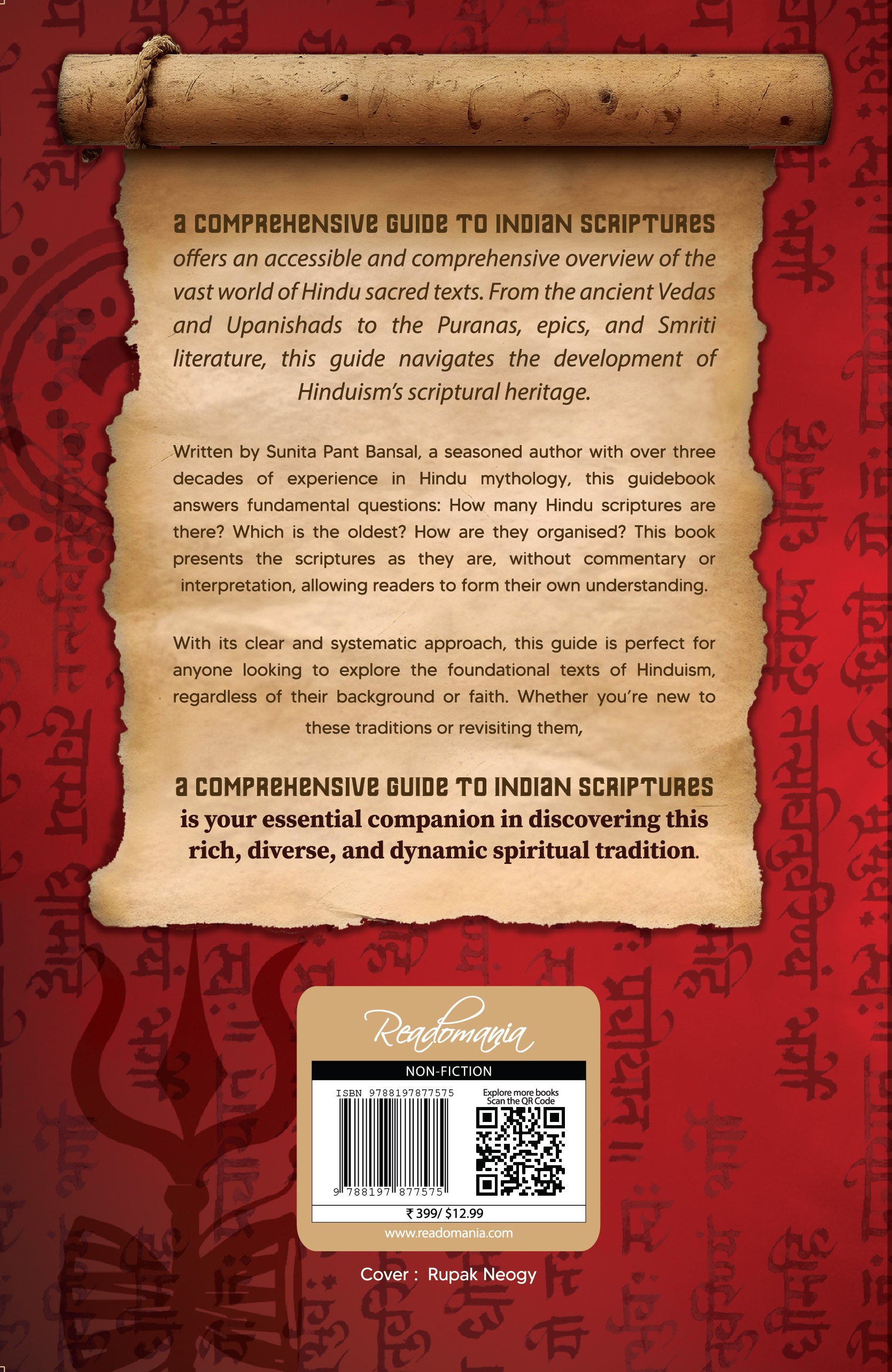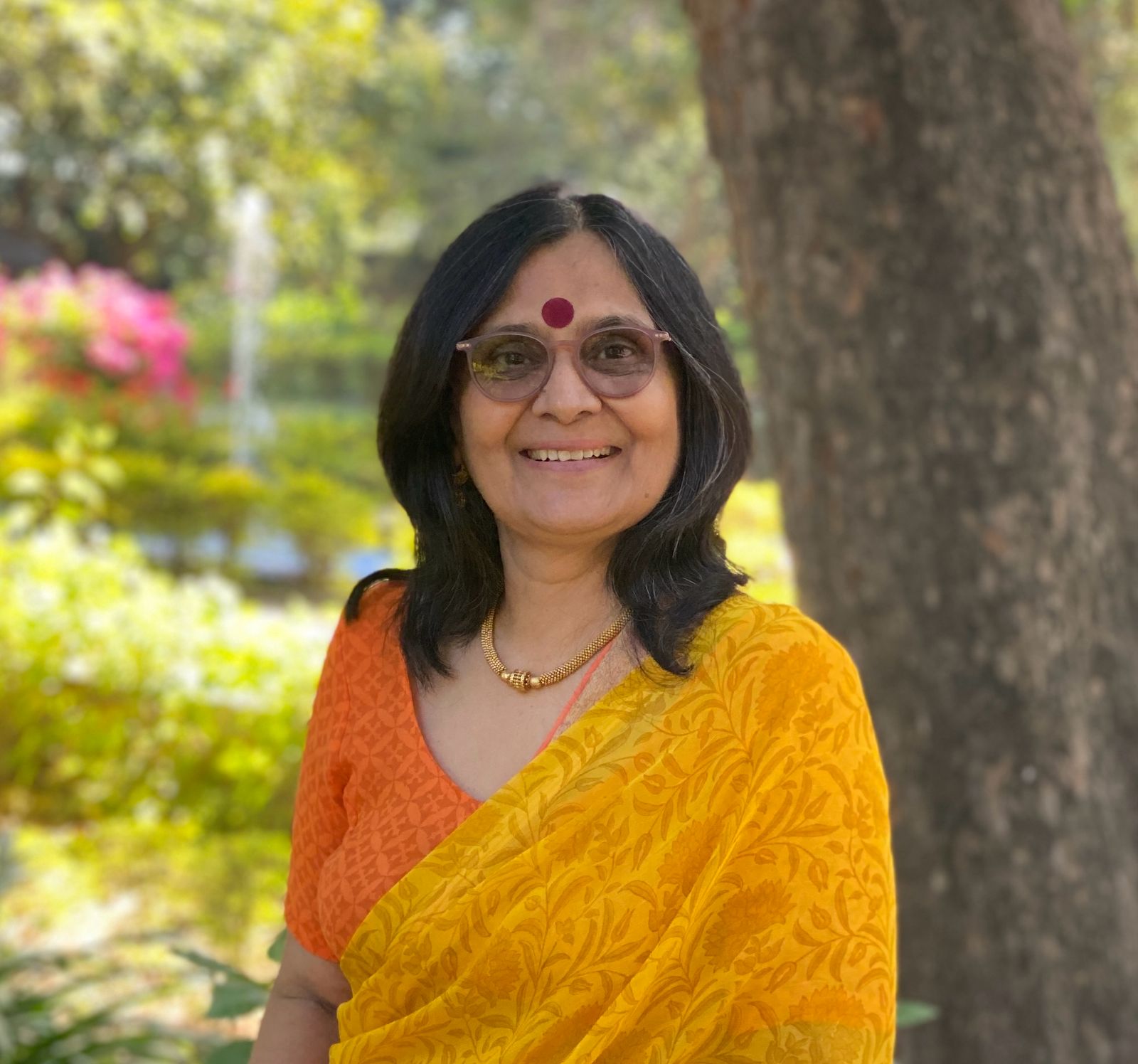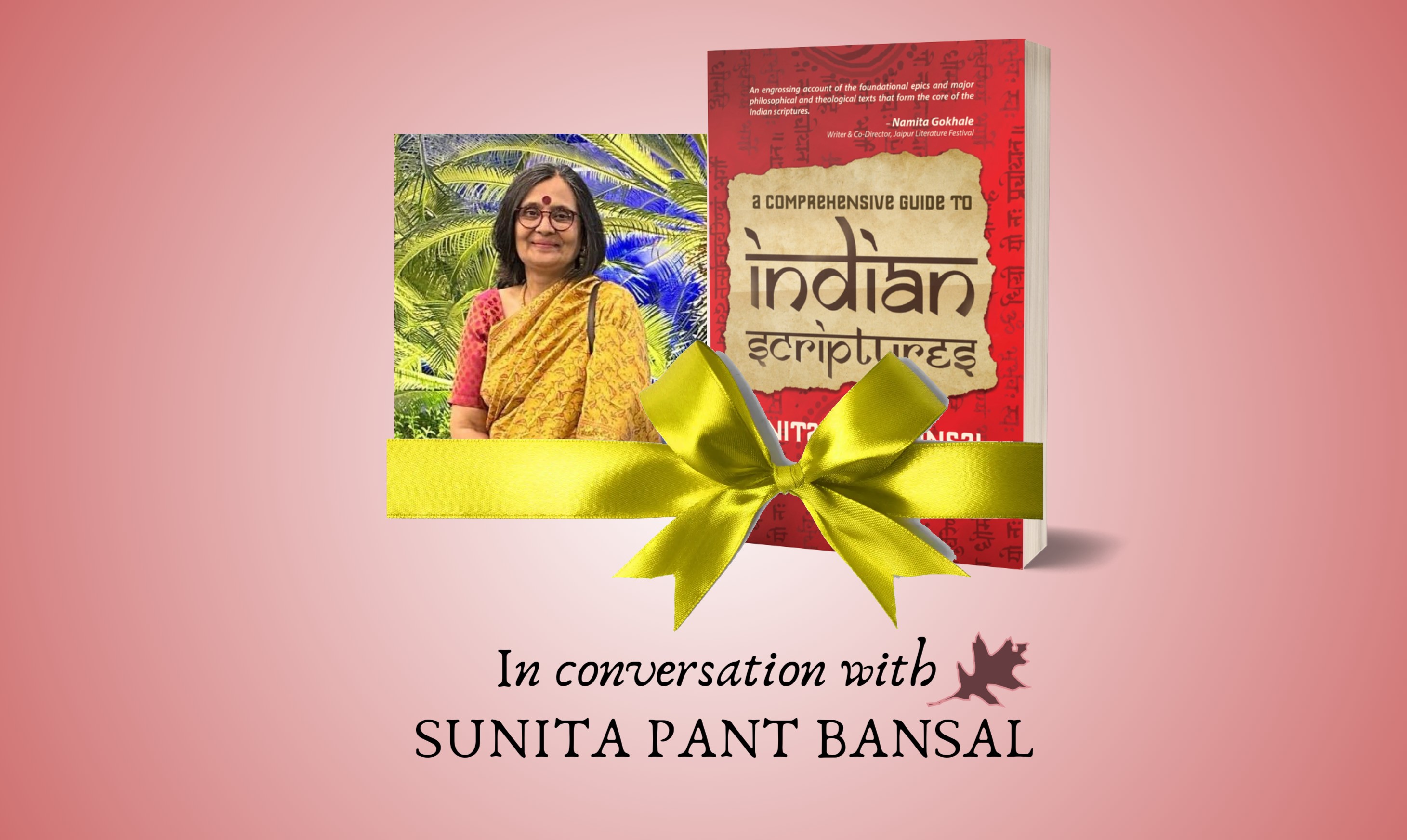Hello Sunita, congratulations on the release of A Comprehensive Guide to Indian Scriptures! We are delighted to be talking to you.
Readomania: What inspired you to write A Comprehensive Guide to Indian Scriptures and what was your goal in creating this resource?
Sunita: Over the last more than three decades I had amassed a collection of reference books, papers, notes, etc related to mythology… since I was writing on the subject. And I would have created this guide for sure—but when—I did not know. Dipankar’s asking me to write this book expedited the whole thing. It was like a dream come true! I’ve always simplified mythology to make it relatable and relevant to our times. When I talk about mythology, I don’t talk about religion, I talk about the philosophy of religion… the stories or the philosophy are for, and applicable, to anyone. This book is written on the same lines.
Readomania: With so many sacred texts in Hinduism, how did you decide which ones to include in the book?
Sunita: I saw whatever books were available on similar lines and my own research told me that I should create some sort of a list based on a tentative historical timeline. Of course, dating of the scriptures has always been controversial so I didn’t really go into that area, since it was irrelevant to my basic idea of just putting things together as a kind of a primer or a guide. Once the list was ready, I realised that each topic/section has its own list. So there, I mentioned those that were universally known.
Readomania: Could you explain the significance of presenting these scriptures without commentary or interpretation?
Sunita: Every scholar, academic, who has read or translated the scriptures, has also given their own analysis and interpretation, which we call as commentary. It is their perspective. Everyone may not agree with that perspective. I felt that I should just lay bare the facts and let people form their own opinions, based on their own perspective, on where they are coming from. I wouldn’t want to impose my thoughts on anyone else… This way, the book will make the reader wonder, think, analyse, question, and maybe even encourage them to delve into the scripture of their choice. In any case, it would have gone against the very grain of Hinduism, which itself does not force you to accept anything. In fact, it tells you to acquire knowledge but use it as per your own wisdom. It respects the fact that everyone should be entitled to their own opinion.

Readomania: How do you think this guide can benefit readers who are new to Hinduism or those revisiting these traditions?
Sunita: I believe this book will help all of us... because none of us know the extent of our scriptural heritage. In that sense, all of us are new to Hinduism—it is too vast and too deep for anyone to know, let alone understand fully. So I would say that this guide would help the reader revisit Hinduism and understand it better. It will help in getting rid of common biases that get formed due to either lack of information or misinformation.
Readomania: What would you say is the most common misconception people have about Hindu scriptures, and how does your book address that?
Sunita: First of all, most people are limited to the Ramayana, the Mahabharata and Gita…which is fine because these are meant for the common man. Then, some people are aware of the terms, Ved-Purana, which in their heads, are for scholars, and Upanishads are for philosophers—which again is not too far away from the truth. So I would say that more than misconceptions, it is the lack of knowledge that I’m trying to address with this book. The schools, our education system, does address this. Our parents and grandparents told us stories from mythology but never told us about the extent of our scriptures. Why? Because it was not relevant. Even today it may not seem relevant for us to know about our own scriptures, but I feel that at least there should be some awareness about our scriptural heritage. This book is meant to bring about that awareness.
Readomania: As someone with over three decades of experience in Hindu mythology, how has your understanding of these scriptures evolved over the years?e
Sunita: Oh, it is still evolving! Initially it was limited to the few names I mentioned just now, the Ramayana, the Mahabharata, the Puranas, Vedas and Upanishads, and of course the Bhagvad Gita. But as I continued simplifying mythology for my readers, I discovered the vastness of the Puranas for instance… I wrote one book about the Puranas for young readers but while doing my research for it, I felt that there should be books on each of the Puranas for them. The same was about the Ramayana. I have written it for all the age groups, yet there is so much more to write from the original Valmiki’s Ramayana. And then there are more than one Ramayana… I’ve mentioned the other interpretations including Ramcharitmanas in the book. This was just discovery of the quantum. It was followed by the evolution of my understanding. To give you a very simple example—once I read about the various Puranas, I saw that they pretty much talk about the same thing in terms of the birth of the universe, genealogy of the dynasties etc.—but depending on the name of the Purana, everything was attributed to one god. So, Vishnu purana would say that everything emanated from the Vishnu and the Brahma purana will say the same for Brahma, likewise for Shiva and Devi or Shakti. So, the God or the creative power, the source is One—whatever names we may want to call it by. This is a tremendous understanding. This is also the beauty of Hinduism that it is so democratic.
Readomania: Can you briefly discuss the differences between the Vedas, Upanishads, Puranas, and Smriti literature?
Sunita: Vedas are the oldest, the Adi or primary Hindu scriptures and the Upanishads are the last part of them, hence also known as Vedanta. The Vedas contain all knowledge of the universe and are also called the Shruti. Smriti literature is the text that follows the Vedas, including the Puranas. We can say that Smriti are the practical application of the philosophical teachings or theories of the Shruti or the Vedas. The Puranas are part of Smriti literature, and simply put, they explain the complicated Vedic philosophy through stories of gods, goddesses, demons, and so on.

Readomania: How do you think A Comprehensive Guide to Indian Scriptures can bridge the gap for readers from diverse backgrounds or faiths?
Sunita: If you read this book with an open mind, just to seek knowledge or information, keeping religion aside for a minute, you will get to see that Indian scriptures do not force any faith on the reader. There is no imposition. The book simply tells you about all the scriptures in brief, as they are, without any commentary or opinion—it’s a trailer of sorts, now it’s up to you to explore whatever you want to further, on your own. The book is truly a guide, showing the way through the maze of Indian scriptures, telling you what comes first and how many of what are there, etc. It kind of maps the vast treasure of our scriptures into a small book, like a primer maybe, or a beginner’s encyclopaedia except that it’s too small and carries only the essence. That’s how it helps to bridge the gap for readers of diverse background.
Readomania: What do you hope readers will take away from your book about the rich spiritual tradition of Hinduism?
Sunita: I am hoping that the readers are able to see the flexibility of Hinduism, which is essentially a way of life that promotes Dharma, which is right action or correct behaviour… and of course what is right or correct is subjective to the situation. Another takeaway is understanding how one person’s personal choice of god can be different from another’s, but the goal they seek are similar. An easy way to put it might be to say that everyone is A (whoever, wherever they are) and everyone has to reach B, which is the source from where we have come and to where we return, and there are zillions of paths to follow between A and B. The choice is ours.
Readomania: Are there any scriptures or aspects of Hinduism that you personally find especially intriguing or impactful?
Sunita: The very fact that Hinduism has no single founder, no central authority, no definitive scripture, and no fixed doctrine, has been most impactful to me personally. It gives me a sense of freedom. And it also gives me choices.
Readomania: Thank you for talking to us, Sunita. We wish the best for all your future endeavours.
The book is available on Amazon globally and on Kindle as well.
 Sunita Pant Bansal is a renowned mythologist, storyteller, and author with a career that spans over four decades. Throughout her journey, she has worn many hats, excelling as a writer, editor, publisher, and entrepreneur.
Sunita Pant Bansal is a renowned mythologist, storyteller, and author with a career that spans over four decades. Throughout her journey, she has worn many hats, excelling as a writer, editor, publisher, and entrepreneur.
She has headed publishing houses and founded and edited newspapers and magazines for readers in India, US and UK. Her contributions to the world of literature extend across multiple platforms, working with prestigious organizations such as Walt Disney, Warner Bros., Pearson Education, The Times of India, Hindustan Times, and ABP Group.
In addition to her global collaborations, Sunita ran her own publishing house creating books for audiences worldwide and served as the President of the esteemed Institute of Indology, further cementing her influence in the literary world.
Sunita has authored over 30 books for adults and young readers, delving into the philosophy of mythology. She has also written innumerable children’s books focused on folk literature and scriptures, which have been translated into multiple languages and sold across the globe. Her books explore and reinterpret the timeless tales of characters from the epics and foundational texts for modern readers. Her storytelling blends mythology with history, making ancient tales accessible in today’s context.


Comments